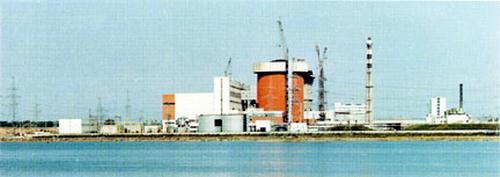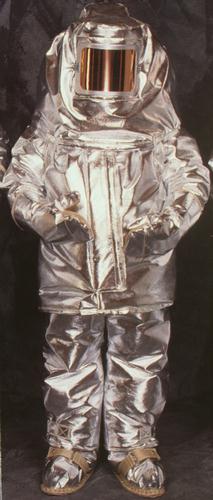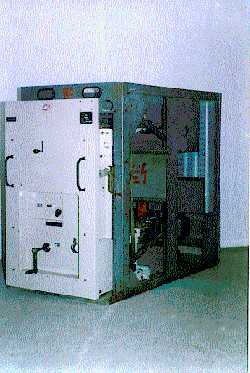
| April 1999 | - Armenia
- Bulgaria - Czech Republic - Hungary - Kazakhstan |
- Lithuania - Russia - Slovakia - Ukraine - United States |
- Cross-Cutting Activities - Planned Activities - Previous Activity Reports |
The April Activity Report documents safety improvements achieved in late March and April at Soviet-designed nuclear power plants through U.S. and host-country cooperation. To request a hard-copy version or to provide comments or suggestions, send an e-mail message to andrea.currie@pnl.gov.
Highlight of the Month
First Plant-Specific Risk Assessment Completed in Ukraine. On April 20, experts from South Ukraine nuclear power plant (NPP) and its contractor Energorisk presented the results of the first in-depth, plant-specific probability risk assessment (PRA) carried out in Ukraine. At a nuclear power plant, a PRA helps determine the most significant risks and set priorities for safety upgrades. The presentation was part of a two-day technical meeting of the Ukraine International Safety Assessment Steering Committee.
The Ukrainian presenters concluded that the results of the PRA will have a significant impact on the operational safety of the VVER-1000/302 units at South Ukraine NPP. Some preliminary insights gained include
- Risk at the plant is dominated largely by operator actions. Symptom-based emergency operating instructions are needed to support consistent operator actions in an emergency.
- Hardware-related risks include the inability to inject coolant via a high-pressure injection system during low-pressure accident conditions. The clogging of sump intake filters due to dispersion of pipe insulation during loss-of-coolant-accident conditions was found to contribute to the risk.
The PRA uncovered a number of problematic design features. One design problem could lead to failure of the backup emergency power supplies to a low-pressure injection system, if off-site power is lost. The problem is that the coolant system for the relevant electrical equipment is not linked into the emergency power supply. If off-site power failed, the electrical equipment could overheat and the low-pressure injection system would lose power. In addition, the control of gate valves at all three emergency feedwater systems would be lost during the short circuit of one direct current busbar. Although these issues are serious, the implementation of design changes would be relatively inexpensive.
 |
| Experts from South Ukraine NPP demonstrated the importance of plant involvement by becoming the first nuclear power plant in Ukraine to complete a plant-specific probabilistic risk assessment. |
As follow-up to the preliminary studies, additional studies and an external review will be completed. However, even these preliminary studies demonstrated the value of carrying out in-depth, plant-specific safety assessments with plant involvement. In fact, plant experts hope to make PRA into a continuous process for monitoring risk, for example by adding a risk monitor at the plant.
During the second day of the meeting, U.S. and Ukrainian specialists discussed issues related to safety assessment of reactor containment and its engineered safety features. The U.S. specialists proposed transferring technology to address these issues to two plants, Zaporizhzhya Unit 5 and Rivne Unit 1. Energoatom is reviewing the proposal. (Walter Pasedag, DOE, 301-903-3628; Jeff Binder, ANL, 630-252-7265)
 | Firefighters and repair technicians at Russia’s nuclear power plants will wear this U.S.-provided protective suit in emergency situations involving high temperatures and ionizing radiation. The Russian enterprise Zashitnaya Odezhda manufactures the SZO-1 suit pictured here. |
The United States has ordered 12 of the SZO-1 suits and 16 of the Sukhovey suits for delivery to Russian plants. Each suit is fabricated separately.
To date, Zashitnaya Odezhda has manufactured and delivered six of the SZO-1 suits to Smolensk, Balakovo, and Novovoronezh NPPs. Suits for the Balakovo and Novovoronezh plants arrived during March 1999. As of the end of April, Kentavr has provided eight of the Sukhovey suits to the Kalinin, Kursk, Balakovo, and Novovoronezh plants. (Rich Denning, PNNL, 614-424-7412)
Smolensk To Benefit from Circuit Breaker Technology Transfer to Russian Enterprises. On April 6, 7, and 8, U.S. team members from the U.S. Department of Energy (DOE) and Pacific Northwest National Laboratory met in Moscow with representatives of Rosenergoatom, Smolensk NPP, and Russian contractors ELOX and Plant Progress to discuss the circuit breaker technology transfer project. Participants reviewed progress on the 6-kilovolt breaker task, resolved outstanding contracting issues on the high-amperage 400-volt breaker task, and planned specific activities for the molded-case 400-volt breaker task.
 |  |
| Circuit breaker system under development for nuclear power plants in Russia consists of a 6-kilovolt breaker and associated trolley. The Russian enterprise ELOX will manufacture and obtain Russian Federation certification for units similar to the prototype assemblies pictured here. Smolensk NPP is the pilot site for system installation. | |
ELOX is making excellent progress toward certification of the 6-kilovolt circuit breakers. Certification by the Russian Federation is expected before the end of September 1999. Plant Progress will begin its certification process for the large-amperage 400-volt circuit breakers in May and expects to achieve certification also before the end of September.
Rosenergoatom identified Western Services to assist in coordinating the engineering activities necessary to design and install approximately eighty 400-volt molded-case circuit breakers into Smolensk NPP by early July 1999. (Norman Fletcher, DOE, 301-903-3275; Ron Wright, PNNL, 509-372-4076)
Detailed Planning Under Way for Novovoronezh Safety Assessment. Novovoronezh plant representatives met in Moscow on April 7 and 8 to plan for preparing a report to Gosatomnadzor on the in-depth safety assessment begun recently for Novovoronezh Units 3 and 4. Participating in the meeting were specialists from Science Applications International Corporation and DOE’s Argonne and Pacific Northwest national laboratories. Experience gained and lessons learned in preparing similar documentation for the Leningrad NPP assessment were presented, providing Novovoronezh representatives a perspective on scope of work, organization, and planning needed to complete the documentation. The group agreed that Novovoronezh staff will begin drafting the plan for the documentation effort. (Walter Pasedag, DOE, 301-903-3628; Phil Pizzica, ANL, 630-252-4847)
Electrogorsk Facility Receives Instrumentation To Aid in Validating Reactor Safety Computer Codes. On April 2, four sets of specialized instruments reached the PSB-VVER test facility in Electrogorsk, Russia. The PSB-VVER is an electrically heated model of a VVER-1000 reactor. Russian specialists will use the PSB-VVER in their work to assess and validate computer codes for evaluating the safety of VVER-1000 reactors.
Each of the four sets of instruments provided by the United States includes a gamma densitometer, used to measure pipe fluid density; a drag screen, to measure the fluid momentum flux; a stainless steel spool to which the densitometer and drag screen are mounted; and the required electronics and hardware. The instrument spools are to be inserted into the facility piping. Used in combination, these instruments will provide accurate data on the average fluid density, fluid velocity, and fluid phase description at the piping location at which they are mounted.
The equipment provided to the Electrogorsk facility consists of instrumentation and electronics used previously in U.S. experimental facilities at Idaho National Engineering and Environmental Laboratory. U.S. specialists redesigned and adapted the instrumentation for use in the Russian work at Electrogorsk. The redesign reduced the equipment cost by half, making it possible to provide advanced instrumentation that will enhance the accuracy of the Russian code assessment work. (Walter Pasedag, DOE, 301-903-3628; Mike Modro, INEEL, 208-526-9402)
RELAP5 Code Validation Projects Reviewed. Russian specialists working to validate the U.S.-developed RELAP5 computer code for use in analyzing the thermal-hydraulics of Soviet-designed reactors gathered in Electrogorsk on April 9 to review the status of their projects for the U.S. team. Participants discussed and finalized two reports documenting comparative assessments for the first two standard problems, one for VVER and one for RBMK reactors. The reports provide insights into the applicability of RELAP5 for modeling some phenomena characteristic of the Soviet-designed reactors. Russian specialists from the Russian International Nuclear Safety Center, the Electrogorsk Research and Engineering Center, and the Russian Research Center-Kurchatov Institute participated in the review with a U.S. team member from Argonne National Laboratory. (Walter Pasedag, DOE, 301-903-3628; Jordi Roglans, ANL, 630-252-3283)
The databases provide key information needed to complete a major part of the in-depth safety assessment under way at Zaporizhzhya Unit 5, namely, the Level 1 probabilistic risk assessment related to internal events that pose threats to safety. The descriptions of plant systems will provide the basis for performing the systems analysis associated with the probabilistic risk assessment. Information on the nuclear steam supply system will be used to develop the RELAP5 thermal-hydraulic model for the reactor system.
Under contract to the U.S. team, specialists from Joint Stock Enterprise-EIS carried out the database development work in Energodar, Ukraine, from August 1998 through April 1999. Scientech, Inc., provided technical assistance to Joint Stock Enterprise, while analysts from Energorisk, Ltd., and project managers from Zaporizhzhya NPP reviewed the work. Argonne National Laboratory representatives of the U.S. team reviewed the work for completeness.
Completion of the Level 1 internal events probabilistic risk assessment will provide the risk profile for the full-power operation of Zaporizhzhya Unit 5. It also will identify vulnerabilities in Unit 5 and identify potential major contributors to possible core damage. Zaporizhzhya NPP management also may use the assessment results in planning safety improvements for Unit 5. (Walter Pasedag, DOE, 301-903-3628; Christian Kot, ANL, 630-252-6151)
Ukrainian Customs Releases Safety Equipment for Delivery to Chornobyl Shelter. After languishing for almost a year in Ukrainian Customs, the bulk of the dose-reduction equipment was released in March to the Chornobyl Shelter. On-site training in the calibration and use of dose-reduction equipment and methods now is planned for completion in the April-September time frame. The gamma spectroscopy system still is in Customs, and portable radiation monitors are being shipped to Ukraine. The primary improvement still to be provided is an update of a whole-body counter in Slavutych. (Dennis Kreid, PNNL, 509-375-2170)
U.S. Training Methodology and Techniques Modeled for Armenia Specialists. Four training specialists from Armenia NPP spent three weeks during April touring U.S. nuclear power plant training centers and working with American specialists at Sonalysts, Inc., in Waterford, Connecticut. The visit was organized to provide the Armenian specialists firsthand observations of how U.S. specialists use techniques for training program development, such as the Systematic Approach to Training. That methodology is employed in the training program development efforts at Armenia NPP sponsored jointly by the International Atomic Energy Agency (IAEA) and DOE. Staff of Sonalysts, Inc., provided training materials and coordinated the visits to the plant training centers. The IAEA provided the financial resources for the visit. (John Yoder, DOE, 301-903-5650; Don Draper, PNNL, 509-372-4079) Initial Shipments of Control-and-Protection System Upgrade Equipment Reach Ignalina. The U.S. Department of Energy and Ignalina NPP are collaborating in a cost-shared project to upgrade the backup control-and-protection system (DAZ 2) for Ignalina Unit 2. The purpose of the DAZ 2 is to back up the primary control-and-protection system to ensure that the plant shuts down properly when conditions warrant it. DOE is providing limited support (financial, engineering, and shipping of equipment) to the plant for this work. Ignalina NPP personnel are taking responsibility for all other activities, such as design and installation as well as development of the safety case for the system. Initial equipment shipments for the DAZ 2 arrived at the plant site in early April. These shipments included sensors, conduit, cable, valves, and structural equipment. Ignalina workers will install the equipment during the Unit 2 maintenance outage scheduled for April through July 1999. The logic cabinets for the system are undergoing manufacture and assembly at the Foxboro Company. They will undergo factory acceptance tests in July before shipment to Ignalina for delivery during September 1999. (Norman Fletcher, DOE, 301-903-3275; Ron Wright, PNNL, 509-372-4076)




